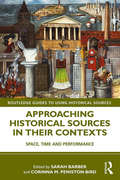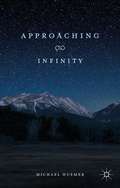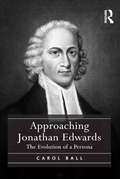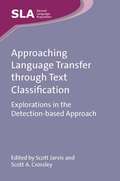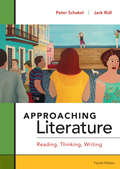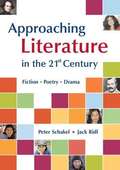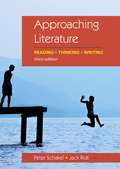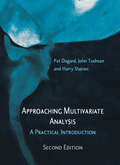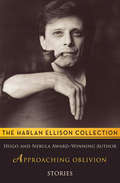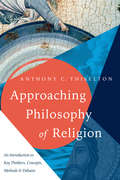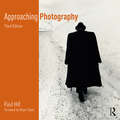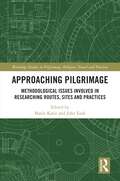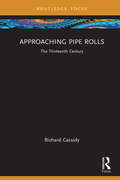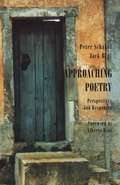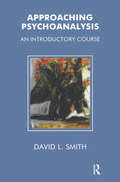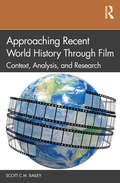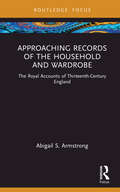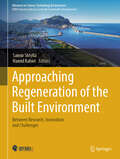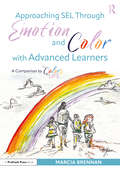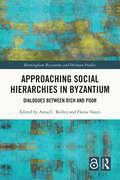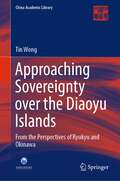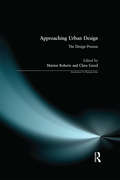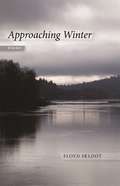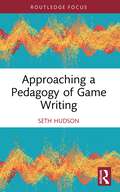- Table View
- List View
Approaching Historical Sources in their Contexts: Space, Time and Performance (Routledge Guides to Using Historical Sources)
by Sarah Barber Corinna M. Peniston-BirdIn Approaching Historical Sources in Their Contexts, 12 academics examine how space, time and performance interact to co-create context for source analysis. The chapters cover 2000 years and stretch across the Americas and Europe. They are grouped into three themes, with the first four exploring aspects of movement within and around an environment: buildings, the tension between habitat and tourist landscape, cemeteries and war memorials. Three chapters look at different aspects of performance: masque and opera in which performance is (re)constructed from several media, radio and television. The final group of chapters consider objects and material culture in which both spatial placement and performance influence how they might be read as historical sources: archaeological finds and their digital management, the display of objects in heritage locations, clothing, photograph albums and scrapbooks. Supported by a range of case studies, the contributors embed lessons and methodological approaches within their chapters that can be adapted and adopted by those working with similar sources, offering students both a theoretical and practical demonstration of how to analyse sources within their contexts. Drawing out common threads to help those wishing to illuminate their own historical investigation, this book encourages a broad and inclusive approach to the physical and social contexts of historical evidence for those undertaking source analysis.
Approaching Infinity
by Michael HuemerApproaching Infinity addresses seventeen paradoxes of the infinite, most of which have no generally accepted solutions. The book addresses these paradoxes using a new theory of infinity, which entails that an infinite series is uncompletable when it requires something to possess an infinite intensive magnitude. Along the way, the author addresses the nature of numbers, sets, geometric points, and related matters. The book addresses the need for a theory of infinity, and reviews both old and new theories of infinity. It discussing the purposes of studying infinity and the troubles with traditional approaches to the problem, and concludes by offering a solution to some existing paradoxes.
Approaching Jonathan Edwards: The Evolution of a Persona
by Carol BallExploring the inner motivations of one of America’s greatest religious thinkers, this book analyses the ways in which Jonathan Edwards' intense personal piety and deep experience of divine sovereignty drove an introverted intellectual along a course that would eventually develop into a mature and respected public intellectual. Throughout his life, the tension between his innately contemplative nature and the active demands of public office was a constant source of internal and public strife for Edwards. Approaching Jonathan Edwards offers a new theoretical approach to the study of Edwards, with an emphasis on his writing activity as the key strategy in shaping his legacy. Tracing Edwards’ strategic self-fashioning of his persona through the many conflicts in which he was engaged, the critical turning points in his life, and his strategies for managing conflicts and crises, Carol Ball concludes that Edwards found his place as a superlative contemplative apologist and theorist of experiential spirituality.
Approaching Language Transfer through Text Classification
by Scott A. Crossley Scott JarvisThis book explains the detectionbased approach to investigating crosslinguistic influence and illustrates the value of the approach through a collection of five empirical studies that use the approach to quantify, evaluate, and isolate the subtle and complex influences of learners' nativelanguage backgrounds on their English writing.
Approaching Literature (Fourth Edition): Reading, Thinking, Writing
by Jack Ridl Peter SchakelApproaching Literature has been designed to give even reluctant students a comfortable way in to literature. The authors Peter Schakel and Jack Ridl set out to use contemporary literary works as entry points to canonical literature and to make the instruction in reading and writing welcoming and accessible to all students, not just potential English majors. With its affordable price, its streamlined and student-friendly text and its commitment to showcasing the most engaging and diverse literary works publishing right now, all students will find something in Approaching Literature that allows them to experience meaningful immersion into the world of literature.
Approaching Literature in the 21st Century: Fiction, Poetry, Drama
by Jack Ridl Peter SchakelNIMAC-sourced textbook
Approaching Literature: Reading + Thinking + Writing (Third Edition)
by Jack Ridl Peter SchakelThe central aim of this book is to foster habits and skills of critical thinking. The third edition makes the book even more inclusive and accessible than the first and second editions. A unique feature of this book is its appendix on reading critical essays, which provides practical instruction on how to approach and read the academic essay, a genre that in itself is unfamiliar to many students, and which students may be asked to use as sources in their own writing.
Approaching Multivariate Analysis, 2nd Edition: A Practical Introduction
by John Todman Pat Dugard Harry StainesThis fully updated new edition not only provides an introduction to a range of advanced statistical techniques that are used in psychology, but has been expanded to include new chapters describing methods and examples of particular interest to medical researchers. It takes a very practical approach, aimed at enabling readers to begin using the methods to tackle their own problems. This book provides a non-mathematical introduction to multivariate methods, with an emphasis on helping the reader gain an intuitive understanding of what each method is for, what it does and how it does it. The first chapter briefly reviews the main concepts of univariate and bivariate methods and provides an overview of the multivariate methods that will be discussed, bringing out the relationships among them, and summarising how to recognise what types of problem each of them may be appropriate for tackling. In the remaining chapters, introductions to the methods and important conceptual points are followed by the presentation of typical applications from psychology and medicine, using examples with fabricated data. Instructions on how to do the analyses and how to make sense of the results are fully illustrated with dialogue boxes and output tables from SPSS, as well as details of how to interpret and report the output, and extracts of SPSS syntax and code from relevant SAS procedures. This book gets students started, and prepares them to approach more comprehensive treatments with confidence. This makes it an ideal text for psychology students, medical students and students or academics in any discipline that uses multivariate methods.
Approaching Oblivion: Road Signs on the Treadmill Toward Tomorrow
by Harlan EllisonThe New York Times called him "relentlessly honest" and then used him as the subject of its famous Sunday Acrostic. People Magizine said there was no one like him, then cursed him for preventing easy sleep. But in these stories Harlan Ellison outdoes himself, rampaging like a mad thing through love ("Cold Friend", "Kiss of Fire", "Paulie Charmed the Sleeping Woman"), hate ("Knox", "Silent in Gehenna"), sex ("Catman", "Erotophobia"), lost childhood ("One Life, Furnished in Early Poverty") and into such bizarre subjects as the problems of blue-skinned, eleven-armed Yiddish aliens, what it's like to witness the end of the world and what happens on the day the planet Earth swallows Barbra Streisand. Oh yeah, this one's a doozy!
Approaching Oblivion: Stories
by Harlan EllisonOver the course of his legendary career, Harlan Ellison has defied--and sometimes defined--modern fantasy literature, all while refusing to allow any genre to claim him. A Grand Master of the Science Fiction Writers of America, winner of the Lifetime Achievement Award from the Horror Writers Association, as well as winner of countless awards, including the Hugo, Nebula, Edgar Allan Poe, and Bram Stoker, Ellison is as unpredictable as he is unique, irrepressible as he is infuriating. Over thirty titles in Ellison's brilliant catalog are now available in an elegant new package featuring Ellison himself. Genius never felt so combustible. The New York Times called him "relentlessly honest" and then used him as the subject of its famous Sunday Acrostic. People said there was no one like him, then cursed him for preventing easy sleep. But in these stories, Harlan Ellison outdoes himself, rampaging like a mad thing through love ("Cold Friend," "Kiss of Fire," "Paulie Charmed the Sleeping Woman"), hate ("Knox," "Silent in Gehenna"), sex ("Catman," "Erotophobia"), lost childhood ("One Life, Furnished in Early Poverty"), and into such bizarre subjects as the problems of blue-skinned, eleven-armed Yiddish aliens, what it is like to witness the end of the world, and what happens on the day the planet Earth swallows Barbra Streisand. Oh yeah, this one is a doozy!
Approaching Philosophy of Religion: An Introduction to Key Thinkers, Concepts, Methods and Debates
by Anthony C. ThiseltonApproaching Philosophy of ReligionApproaching Philosophy of Religion
Approaching Photography
by Paul HillFully updated and revised, this seminal book explains and illustrates what photographs are, how they were made and used in the past and, more particularly, what their place is in the creative arts and visual communications world of today. Paul Hill looks at photographs as modes of expression and explores the diversity of approaches taken when creating photographs and what these mean for a photographer’s practice and purpose. It emphasises the importance of contextualisation to the understanding of the medium, diving into the ideas behind the images and how the camera transforms and influences how we see the world. With an impressive collection of 200 full colour images from professional practitioners and artists, it invites us to consider the foundations of photography’s past and the digital revolution’s impact on the creation and dissemination of photographs today. Essential reading for all students of photography, it is an invaluable guide for those who want to make a career in photography, covering most areas of photographic practice from photojournalism to fine art to personal essay.
Approaching Pilgrimage: Methodological Issues Involved in Researching Routes, Sites, and Practices (Routledge Studies in Pilgrimage, Religious Travel and Tourism)
by John Eade Mario KatićThis volume seeks to explore pilgrimage studies as a distinctive sub-field of research, and to define its key methodological approaches and problems. Pilgrimage studies has long been influenced by such academic disciplines as anthropology and this volume considers the new insights that pilgrimage studies can offer to these disciplinary fields. Bringing together experienced pioneers and a younger generation of pilgrimage scholars, the chapters address the directions contemporary pilgrimage research is taking and how it is developing into the future. Covering topics like digital pilgrimage, multi-site pilgrimages, and long-term ethnography, with examples from Europe, the Middle East, and Japan, this is an important resource for all researchers engaging with pilgrimage.
Approaching Pipe Rolls: The Thirteenth Century (Approaching Medieval Sources)
by Richard CassidyThis is the first study specifically concerned with thirteenth-century pipe rolls and shows how pipe rolls were compiled, what they contain, and how to read them. These records of English government finance were produced annually. They list debts owed to the government, by the sheriffs of each county, by manors and boroughs, and by individuals for taxes, fines and judicial penalties. They also list the payments made, sometimes in cash to the treasury, sometimes for building works, fees for royal employees and relatives, the provision of castles, and much more. The rolls are an essential source for administrative history, and provide detailed information for family and local historians. All the rolls are now readily available, either in print or online, but they are at first sight difficult to understand. This book shows how the rolls evolved in the course of the century and serves as a guide for beginners, armed with some basic Latin, who want to explore these records. As well as explaining the conventions of dates, numbers, abbreviations, monetary units and so on, it illustrates the material to be found in pipe rolls by a detailed examination of a single roll.
Approaching Poetry: Perspectives and Responses
by Jack Ridl Peter SchakelThis wide-ranging introduction to poetry blends theoretical considerations with a thorough introduction to the elements of poetry, offering alternative perspectives from which to approach and engage with a poem.
Approaching Psychoanalysis: An Introductory Course
by David Livingstone SmithThis book provides the scope and complexity of Freud's contributions and emphasizes the wide proliferation of the Lacanian approach. It describes psychoanalytical theories, and is helpful for the readers as a stimulus to independent investigation and critical thought.
Approaching Recent World History Through Film: Context, Analysis, and Research
by Scott C.M. BaileyApproaching Recent World History Through Film: Context, Analysis, and Research explores the relationships between twentieth-century world history and film by providing analysis of a diverse range of films organized by global history topics, including war and conflict, decolonization, political economy, and long-distance travel. This insightful text describes how to analyze films as original historical sources and how to carry out research projects using films. The text provides guidance on the types of world history films, their conventions, and how to analyze the historical arguments in movies. Scott C.M. Bailey incorporates in-depth discussions of the historical content and context of a wide range of international films connected with important twentieth-century global history topics. The book also offers many prompts for discussion, historical timelines, and suggestions for further reading and viewing, as well as instructions on how to construct research papers and projects which employ the use of films as historical sources. This book will be of interest to students in world history and film history courses.
Approaching Records of the Household and Wardrobe: The Royal Accounts of Thirteenth-Century England (Approaching Medieval Sources)
by Abigail S. ArmstrongRecords of the household and wardrobe are important sources for understanding English royal medieval government. This book outlines their functions, organisation and development, along with the activities and accounts of the various officials and departments charged with their undertaking.The household was the political centre, encompassing a variety of departments catering to the day-to-day needs of the royal family and the court. The wardrobe was originally the location where cloth and other precious commodities were stored. Still, it took on increasing importance over the thirteenth century as the key financial and administrative office that itinerated alongside the king. This overview of the different types of household and wardrobe accounts and their contents demonstrates the wealth of information contained within these records. Conventions of language, abbreviations, money, numbers and dates are also explained. The two case studies illustrate how a household diet account and a wardrobe jewel account can be used to elucidate the actions and agency of Queens Eleanor of Provence and Margaret of France.As an introduction to the thirteenth-century household and wardrobe and their records, this book is an excellent guide for students and researchers who wish to use these documents in their research.
Approaching Regeneration of the Built Environment: Between Research, Innovation and Challenges (Advances in Science, Technology & Innovation)
by Saimir Shtylla Hamid RabieiThis book approaches three important aspects related with urban regeneration such as research, innovation and challenges. In light of its growing interdisciplinarity, the selected contributions extend the debate to the importance of the cooperation between various disciplines, attention to the latest design and technological trends, as well major inclusivity of citizens for a correct decision-making process leading afterwards into successful development, test and implementation of innovative solutions. An important focus will be set on the important role innovations play in the preservation and management of heritage sites in response to the climate and urban challenges encountered. Also, this contribution aims to transmit the importance of local interventions in the achievement of urban regeneration as an impulse for the achievement of the common global climate goals in the years ahead.
Approaching SEL Through Emotion and Color with Advanced Learners: A Companion to The Colors of Life
by Marcia BrennanApproaching SEL Through Emotion and Color provides all the information you need to successfully guide your classroom or child through the subject matter presented in The Colors of Life book.Social and Emotional Learning (SEL) is a pedagogical rubric that focuses on children’s ability to integrate thinking, emotions, and behavior. The narratives, images, and exercises featured in this guidebook engage SEL subjects through learning activities such as imaginative visualizations, reflective journaling exercises, creative writing prompts, and related visual arts projects. These activities allow the student to explore powerful emotions that may not be included in the traditional curriculum of STEM-oriented learners.Presenting strategies for the practical implementation of The Colors of Life, this guidebook is the perfect tool for educators and parents of middle school students.
Approaching Social Hierarchies in Byzantium: Dialogues Between Rich and Poor (Birmingham Byzantine and Ottoman Studies)
by Anna C. Kelley Flavia VanniUtilising new methodological approaches to understanding not only the poor as a social and economic group but also of the internal means of stratification which informed social organisation within local communities, this book looks at the place of the poor within the multi-layered hierarchies of Byzantine society using evidence from archaeology, art, architecture, as well as narrative, theological, and legal texts. Rather than treating the different levels of society independently, it looks at the social interactions which replicated and reinforced hierarchies but were also subject to negotiation within local communities. Fifteen leading Byzantine scholars discuss and analyse the topic of social hierarchies in the Byzantine Empire, covering topics such as working lives, the material world, the stratification of space, and philanthropy and social obligation.The book will appeal to scholars and students alike interested in identity formation and expression in the Byzantine provinces, as well as those researching the social history of the poor in Byzantium, and the mechanisms of hierarchies, social marginalisation, and oppression.
Approaching Sovereignty over the Diaoyu Islands: From the Perspectives of Ryukyu and Okinawa (China Academic Library)
by Tin WongThis book discusses the sovereignty over the Diaoyu Islands from the perspectives of Ryukyu and Okinawa. Written in chronological order, the book has 13 chapters featuring 121 documents and maps. The first 12 chapters explain, based on detailed historical facts on the Diaoyu Islands, the rise and decline of the Ryukyu Kingdom and the historical roles of China, Japan, and the United States in the history of the kingdom. The final chapter is an overview of the Sino-Ryukyuan, Japan-Ryukyuan and US-Ryukyuan relations, and further clarifies the issue of ownership of the Diaoyu Islands and their strategic position. The book demonstrates that Ryukyu did not have sovereignty over the Diaoyu Islands, refutes Japan’s claim that these islands were a part of the Ryukyu Kingdom, and reveals the causes and consequences of the Sino-Japanese conflicts created by the United States. The book examines the 500-year friendship between China and Ryukyu, recounting moving stories. Lastly, citing ancient documents and more, the books proves that the Ryukyus never owned the Diaoyu Islands and that these islands belong to China.
Approaching Urban Design: The Design Process (Introduction To Planning Series)
by Clara Greed Marion RobertsThis companion to Introducing Urban Design: Interventions and Responses shows how the principles and concepts of urban design can be applied and implemented in a range of real-world settings.
Approaching Winter: Poems
by Floyd SklootFloyd Skloot's eighth poetry collection, Approaching Winter, evokes the fluid and dynamic nature of memory as it ebbs and floods through our daily lives. Here the real and the imagined intermingle freely: In one poem, the cry of eagles reflects the wails of an infant daughter, long since grown and gone; in another, an aging Samuel Beckett prepares to throw the first pitch at Ebbets Field. Traveling from Portland's Willamette River, which borders Skloot's home, to the hushed landscapes of the afterlife, the poems in this collection acknowledge the passage of time and the inevitable darkness that lies ahead. Yet Skloot also remains attuned to the urgency of the present moment, as he admires the plumage of the local birds in the short days before their journey south for the winter. By turns whimsical and meditative, Approaching Winter gives voice to the struggle to find coherence in a fragmented world.
Approaching a Pedagogy of Game Writing
by Seth HudsonThis book examines the practices of writers in the AAA video game industry, to provide a model for game writing pedagogy that highlights the roles and skills utilized by these innovative storytellers. Based on a two-year qualitative study, gathering data through conversational interviews, Seth Hudson combines theory, practice, and his experience as an educator-researcher to shed light on the phenomenon of game writing and writers who drive innovation in game storytelling. The author gives context for a range of audiences, examining the role of computer game design (CGD) in higher education, the role of writing and narrative design within those programs, the current and historical challenges game writers face, and the purpose of the research underpinning this book. Hudson frames a synthesis of research findings and relevant theory to illustrate new teaching practices informed by his findings that will help better serve students. This book will provide an essential resource for game studies and game design educators and researchers, as well as game narrative enthusiasts.
